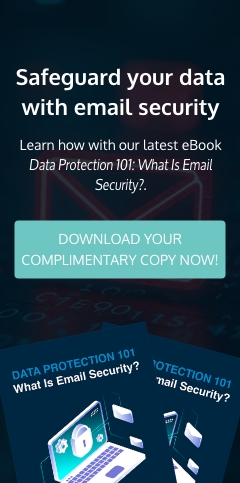Many cyberattacks start with phishing campaigns. And if you fail to implement some form of email authentication, your company can suffer financial and reputational damage. Fortunately, there’s a solution that you can use to protect your organization: Domain-based Message Authentication Reporting and Conformance (DMARC).
DMARC: An introduction
To understand DMARC, we must first take a look at DomainKeys Identified Mail (DKIM) and Sender Policy Framework (SPF), the two email authentication standards that DMARC is built upon.
DKIM
Cybercriminals can forge your name and email address to make it look like the emails they're sending to your colleagues and business partners are coming from you. DKIM was created to prevent such email forgeries.
Think of DKIM as something that adds an ID or unique signature to your email address. When you send an email, the sending server attaches that signature to your message so that the receiving server can confirm that the email really came from you.
DKIM validates a user’s identity by using a pair of encrypted keys to add a digital signature to every email. Receiving servers use the signature to validate the sender’s authenticity and determine if the message was altered during transit.
DKIM enables mailbox providers (MBPs) like Google and Yahoo to use email metadata to create a reputation for your email domain. If you have great email practices (e.g., low bounce rates, high engagement), MBPs are more likely to trust your email domain.
SPF
SPF enables organizations to list the mail servers that are permitted to send emails from their domain. When you receive an email, the receiving server looks up the domain name listed in the return address. If the IP address of the sending email server is unauthorized, the receiving server may flag the message as spam.
DMARC is more than the sum of DKIM and SPF
SPF and DKIM are email authentication methods in which recipient servers verify and screen email messages according to the validity of those messages. DMARC, on the other hand, allows you to create a policy that details your email authentication practices and provides receiving mail servers with policy enforcement instructions.
How does DMARC work?
DMARC relies on SPF and DKIM standards. The DMARC validation process generally works this way:
- A domain administrator issues their email authentication policies. This includes instructions on how receiving mail servers should handle mail that fails to comply with this policy.
- After an inbound mail server receives an email, it gets the domain name from the message's "From" header and retrieves the DMARC policy from the DNS records of that domain. The inbound server then checks the message for the following things:
- Validity: Is the message’s DKIM signature authentic?
- Authorization: Did the message come from an IP address permitted by the sending domain’s SPF records?
- Legitimacy: Does the message’s header show correct “domain alignment”?
- Using this information, the inbound server will use the sending domain’s DMARC policy to decide whether to accept, reject, or flag the email.
- Finally, the receiving mail server will relay the result to the sending domain owner.
Related article: 7 Reasons why your business email needs encryption
Why do you need DMARC for your business?
DMARC provides your organization with the following benefits:
1. Reduced risk of cyberattacks
DMARC makes it difficult for cybercriminals to spoof your email, launch phishing and spam campaigns, and reach their targets. As a result, it stops cybercriminals from sending your employees fake emails claiming to be your executive/employees. It also prevents the abuse of your domain outside of your company, like a criminal sending a fraudulent email to your customers.
2. Improved email deliverability
Spoofed and fraudulent emails may reduce the likelihood of your messages landing in your recipient's inbox and can get your email domain blacklisted by MBPs. By addressing these issues, DMARC improves the deliverability of your emails.
3. Reduced financial costs
According to a study, a single phishing email could cost a small business $100,000. Moreover, if cybercriminals were to spoof your email address, affected parties might turn to you for help, which can increase your customer support costs. By using DMARC to block fraudulent emails, your business can avoid paying exorbitant amounts.
How do you implement DMARC?
Improper implementation of DMARC is risky. But with NetQuest as your IT partner, you don’t need to worry about the technical stuff! Let us help you implement authentication standards like DMARC to protect your Baltimore, Annapolis, or Towson business from malicious emails. Talk to us today to learn more.


